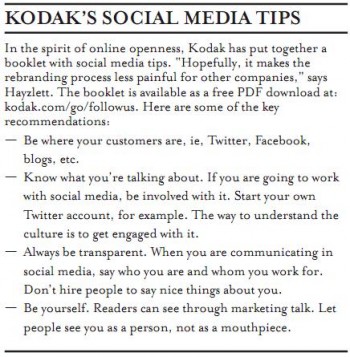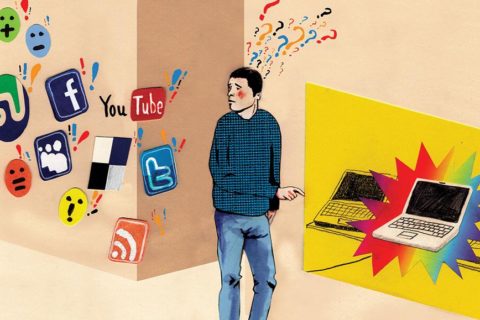Robert Heeg
First published in Research World December 2009.
When digital photography took off, Kodak faced quick extinction like so many other iconic brands. Jeffrey Hayzlett explains what brought the 130-year-old company back from the brink.
Jeffrey Hayzlett, chief marketing officer and vice president at the Eastman Kodak Company, has lost count of the times people told him: ‘Your company won’t be around for much longer.’ After all, in the new age of digital media, there is no room for an old-world brand like Kodak. But Hayzlett has stopped listening. “Most of these people who tell us we’re past our prime are social media or brand consultants. They give us the bad news and then want us to hire them.”
Nowadays, Kodak has little need for these consultants. The brand managed to do what few of their contemporaries could: they’ve adapted to the new playing field and actually turned it to their advantage. Kodak did so by embracing social media and using new Web 2.0 methods to engage with its customers. By creating free applications like the Konga Line for Facebook or SmileMaker for the iPhone, Kodak literally puts smiles on people’s faces.
Change or die
Many imaging companies, including the iconic Polaroid, went bankrupt in the digital age. It seemed that the same fate awaited Kodak. By making photography accessible to nearly everyone with its film and user-friendly cameras, it became a multinational corporation and a brand recognised around the world – but it was that same head start that threatened to become a disadvantage for the company in the digital age. Hayzlett cites Jim Collins’ latest book How The Mighty Fall: And Why Some Companies Never Give In: “He writes about overcoming ‘the hubris of success’. We were the game when it came to photography, and that changed with the advent of digital.”
How close a call it was for Kodak is not relevant to Hayzlett, who instead stresses the urgency of its rebranding operation. “It was change or die, so we focussed on changing the business model.” To underline this need, he asks how many people have bought a roll of film in the last few months. The answer is likely, very few. Yet, almost everyone carries a digital camera or camera phone nowadays. With arguably more people than ever involved in photography, the digital threat was quickly recognised as an opportunity for Kodak.
Photography is still about ‘sharing’, the company realised, and the George Eastman slogan from 1888 (‘You press the button, we do the rest’) could easily be applied to the digital age. With easy-share options enabling customers to enjoy and exchange their pictures over the web, new media has created more potential ‘special Kodak moments’ than ever before. In platforms like Facebook or Twitter, people use these possibilities to the fullest extent. So why not rebrand Kodak from a faithful old friend to a fresh new face in social media?
The trust factor
In order to be accepted in social networks, a brand first needs to be trusted. That was no problem for Kodak, says Hayzlett. “We’ve been taking care of your Kodak memories for 130 years. We’re probably the only product you run back into a burning building to save.”
However, it’s more difficult to then use that trust to move the brand and create excitement around it. Unless the products are there to support it, adds Hayzlett. “A brand is nothing but a promise delivered. If you don’t deliver, your brand can slip and get tarnished. So we’re really reinventing the categories we’re in; we’re shifting our business model around a lot, and that means our brand’s coming back.”
One of the first companies to hire a chief blogger, Kodak now practices word-of-mouth marketing by example. This is where the brand’s chances lie, says Hayzlett. “We engage with our customers. These conversations are happening, so why not participate and become a much richer company – first from the relationships, and hopefully from the revenue as well. Because the stronger the relationship with your customers, the more they’ll purchase over time.”
Two-way conversation
Watching Hayzlett talk at the new media event Picnic earlier this year in Amsterdam, it’s easy to see why Kodak has succeeded so well in reconnecting with customers over the web. He entertains, he jokes, informs, tells personal anecdotes; all the ingredients that matter in online communication. Engagement is key in a Web 2.0 environment. Why else, with a choice of zillions of blogs, tweets and real online friends, would someone interact with a brand? Hayzlett explained Kodak’s ‘four E’s’ of web strategy: engage, educate, excite, and evangelise. “If I engage with customers, I get better. And people see that. If I can solve a person’s problem, then we both get excited. And then I can get them to evangelise. That’s the wow factor. Getting millions of people to talk about you.”
Online communication is two-way. Co-creation is therefore part of Kodak’s web strategy. An example: the microphone jack on the new Zi8 pocket camera was an idea from a customer who bought an earlier version, says Hayzlett. “He thought we’d sell a lot more with a mike jack. He was right.” The name for the next version will also come from a customer, as the company sent out tweets to start a naming contest. “In five days, we received thousands of entries. The winner will stand on stage with us to announce the name and celebrate in the success. That’s co-creation.”
Always connected
As they navigated the social web, Hayzlett and his team learned a lot; for instance, how to reach out further, and how to save a lot of money. “We’re able to use what I call OPM: other people’s money. We injected ourselves into stories and into people’s lives.”
Kodak’s chief blogger will soon be joined by a chief listening officer, who will act as a ‘sort of air traffic controller’ for the brand. The online activities reduce the need for certain types of research, says Hayzlett. “I don’t think you need to do a lot of the traditional stuff, like phone surveys. And the focus groups will probably move away from the traditional people-watching in a room with a glass mirror. The great thing about social media and the connectivity online is that it puts the product management teams directly in touch with the customers, with no filters. In real-time, we’re seeing suggestions on the products and the use of them, and how people are affected. And that’s a very big benefit for a company like Kodak.”
Nevertheless, Kodak invests heavily in research. “We wanted to find out how people are connecting in today’s world. It’s an always-connected society, but how do people get face-to-face? Research allows us not only to get in-depth perceptions about our products, but also where the trends are going.”
 A ‘reconnectivity’ study pointed Kodak in the direction of newly evolved ‘breeds’, like the technical executive who is always on the road and always connected, pulling out his Blackberry and iPhone, with every gadget in his arsenal. Hayzlett describes another phenomenon: the digital family. “They’re connected, the kids know how to run every device and set up networks, and the female head of household acts as the chief memory officer; in charge of sharing all the memories and keeping them.”
A ‘reconnectivity’ study pointed Kodak in the direction of newly evolved ‘breeds’, like the technical executive who is always on the road and always connected, pulling out his Blackberry and iPhone, with every gadget in his arsenal. Hayzlett describes another phenomenon: the digital family. “They’re connected, the kids know how to run every device and set up networks, and the female head of household acts as the chief memory officer; in charge of sharing all the memories and keeping them.”
Painful transition
There are countless examples of brands and indeed, entire industries, that struggled with the new media revolution. A signal example is the music industry, where turnovers plunged as consumers stopped buying CDs in favour of downloading MP3s. They have much to learn from Kodak, it seems. Hayzlett says that he was recently approached by someone from the music industry who invited him to give a presentation on how Kodak brought about their transformation. Similar requests came in from the newspaper business and other segments that suffered heavy losses after the web nearly destroyed their business models.
Hayzlett is always keen to advise but warns that the shift to openness can be painful. “You have to be careful in social media because you’re sharing lives out in the open. It creates some hard discussions within a company. We have a culture of healthy debates, so it was less painful for us. But it did require some education.”
The next terrain to be explored by Hayzlett is mobile marketing. It’s not there yet, but he senses it’s on the rise and says that Kodak wants to better understand the mobile field. He lists couponing, reimbursements and affinity clubs; all of them good tools, now it’s just a matter of how Kodak is going to use them. “You have to be careful because consumers are probably paying for it and it can be the most intrusive medium. Send somebody something on a mobile that they don’t want, and they’ll throw their device through the window of the same coffee shop that they just got the message from.” Kodak soon hopes to publish results on their mobile findings, as they’ve done with social media (see box).
Like IBM and Apple, Kodak stepped back from the brink of failure. Apart from utilising social media, it’s with innovative products like the Zi8 pocket camcorder that the company seeks to re-establish itself as the brand for sharing memories. “If you don’t get that, you can’t be looking around much,” says a confident Hayzlett. “We may have been a slow starter, but man, are we finishing fast.”
 Jeffrey Hayzlett is chief marketing officer and vice president at the Eastman Kodak Company
Jeffrey Hayzlett is chief marketing officer and vice president at the Eastman Kodak Company



3 comments
Jeffrey Hayzlett, former CMO of Eastman Kodak, chngae agent, and best-selling author of The Mirror Test said, “The most value is created by driving chngae. But now, it’s not a luxury—it’s survival. Read this book and thrive!” Hayzlett continued, “The old days of delaying tough decisions and sacrificing business fundamentals for short-term stock gains are gone.” “Now, business is back to the fundamentals—and that means making the chngaes necessary to be competitive in a world of increasing competition and continued economic difficulties.” “Brett Clay is right. Executives must look at themselves in the mirror and ask themselves if they want to be masters, or victims, of chngae. If they want to by masters, they should read ‘Selling Change.’”
[…] /2011/01/24/dinosaurs-go-digital-the-re-branding-of-kodak/ […]
Apparently, Kodak’s bankruptcy concerns followed when they were warned that their shares were to be removed from the New York Stock Exchange if Kodak’s stock price continued to remain below one dollar for the next 180 days.
They might avoid chapter 11 bankruptcy if they sell their digital imaging patents.
Joseph S. Pearl, LL.M. – A Professional Law Corporation
1400 Chester Ave., Suite C
Bakersfield, CA 93301
661-281-0253